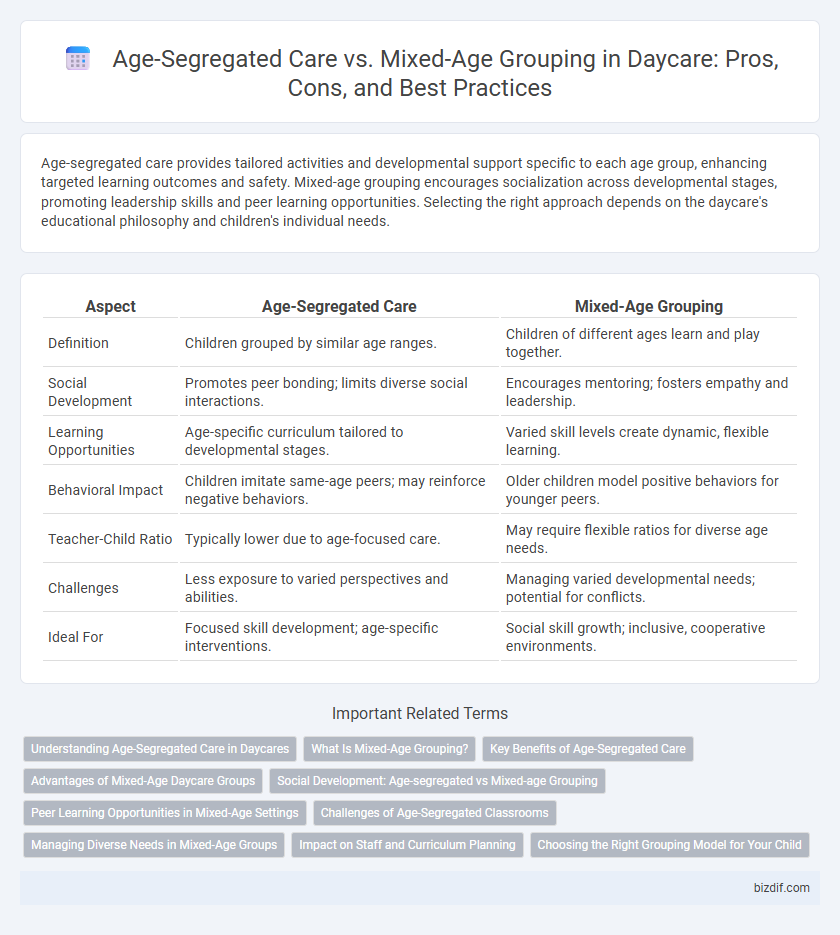Age-segregated care provides tailored activities and developmental support specific to each age group, enhancing targeted learning outcomes and safety. Mixed-age grouping encourages socialization across developmental stages, promoting leadership skills and peer learning opportunities. Selecting the right approach depends on the daycare's educational philosophy and children's individual needs.
Table of Comparison
| Aspect | Age-Segregated Care | Mixed-Age Grouping |
|---|---|---|
| Definition | Children grouped by similar age ranges. | Children of different ages learn and play together. |
| Social Development | Promotes peer bonding; limits diverse social interactions. | Encourages mentoring; fosters empathy and leadership. |
| Learning Opportunities | Age-specific curriculum tailored to developmental stages. | Varied skill levels create dynamic, flexible learning. |
| Behavioral Impact | Children imitate same-age peers; may reinforce negative behaviors. | Older children model positive behaviors for younger peers. |
| Teacher-Child Ratio | Typically lower due to age-focused care. | May require flexible ratios for diverse age needs. |
| Challenges | Less exposure to varied perspectives and abilities. | Managing varied developmental needs; potential for conflicts. |
| Ideal For | Focused skill development; age-specific interventions. | Social skill growth; inclusive, cooperative environments. |
Understanding Age-Segregated Care in Daycares
Age-segregated care in daycares organizes children into groups based on similar age ranges, typically within a 12-month span, to tailor developmental activities and promote age-appropriate learning experiences. This structure allows caregivers to focus on specific milestones and social skills relevant to each age group, enhancing individualized attention and safety. Research indicates that age-segregated settings can support targeted cognitive and motor development, though they may limit cross-age social interactions found in mixed-age environments.
What Is Mixed-Age Grouping?
Mixed-age grouping in daycare refers to the practice of caring for children of various ages within the same classroom or play area, promoting social development by encouraging peer learning and mentorship. This approach fosters a family-like environment where older children model positive behaviors and younger ones benefit from observing advanced skills. Research shows that mixed-age settings enhance cognitive flexibility and emotional resilience by exposing children to diverse perspectives and challenge levels.
Key Benefits of Age-Segregated Care
Age-segregated daycare groups children by similar developmental stages, allowing tailored activities that match their cognitive, social, and physical needs. This approach enhances focused skill-building and peer bonding, resulting in improved developmental outcomes. Caregivers can efficiently address age-specific challenges, promoting a structured environment that supports consistent routines and learning milestones.
Advantages of Mixed-Age Daycare Groups
Mixed-age daycare groups promote social development by encouraging older children to model positive behaviors for younger peers, fostering empathy and cooperation. These settings support individualized learning, allowing children to progress at their own pace through interaction with diverse age levels. Exposure to varied skill sets and perspectives enhances problem-solving abilities and adaptability among all age groups.
Social Development: Age-segregated vs Mixed-age Grouping
Age-segregated daycare environments foster social development by allowing children to interact with peers at similar developmental stages, which can enhance age-appropriate skills and reduce social anxiety. Mixed-age grouping promotes social adaptability and leadership as younger children learn from older peers while older children develop empathy and mentoring abilities. Research indicates that mixed-age settings encourage diverse social interactions, resulting in improved communication skills and increased cooperation among children.
Peer Learning Opportunities in Mixed-Age Settings
Mixed-age daycare settings enhance peer learning opportunities by allowing younger children to observe and imitate older peers, fostering natural mentorship and social skill development. Older children reinforce their knowledge and leadership abilities through guidance and collaboration with younger classmates. This dynamic encourages empathy, cooperation, and cognitive growth across diverse age groups within the daycare environment.
Challenges of Age-Segregated Classrooms
Age-segregated classrooms often face challenges such as limited social interaction, which can hinder the development of empathy and communication skills across different age groups. Younger children may struggle to keep up with the curriculum designed for their specific age, while older children might feel unchallenged or disengaged. This rigid grouping can reduce opportunities for peer learning and mentorship, which are valuable in mixed-age daycare settings.
Managing Diverse Needs in Mixed-Age Groups
Managing diverse needs in mixed-age daycare groups requires tailored approaches to accommodate varying developmental stages, promoting socialization and empathy among children aged 1 to 5 years. Caregivers implement individualized activities that foster cognitive and emotional growth while maintaining safety standards for all age ranges. Mixed-age environments enhance peer learning, with older children reinforcing skills and younger ones benefiting from modeling behaviors.
Impact on Staff and Curriculum Planning
Age-segregated care simplifies curriculum planning by allowing staff to tailor activities and developmental goals to a specific age group, enhancing skill-targeted instruction and reducing the complexity of managing diverse needs. Mixed-age grouping challenges staff to design flexible curricula that accommodate varying developmental stages, requiring increased training and adaptability to address a broader range of cognitive, social, and emotional milestones. Staff workload in mixed-age settings may increase due to individualized attention demands, but this approach can foster peer learning and mentorship opportunities, influencing curriculum objectives and teaching strategies.
Choosing the Right Grouping Model for Your Child
Choosing the right grouping model in daycare depends on your child's developmental needs and social preferences. Age-segregated care offers targeted activities that align with specific age milestones, promoting skill development in a focused environment. Mixed-age grouping fosters peer learning and socialization by encouraging interactions across different developmental stages, enhancing adaptability and empathy.
Age-segregated care vs Mixed-age grouping Infographic

 bizdif.com
bizdif.com